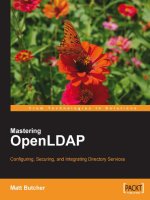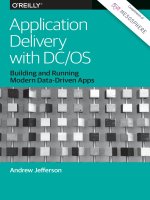IT training CA technologies OReilly securing microservice APIs khotailieu
Bạn đang xem bản rút gọn của tài liệu. Xem và tải ngay bản đầy đủ của tài liệu tại đây (2.82 MB, 51 trang )
Securing Microservice APIs
Sustainable and Scalable
Access Control
Matt McLarty, Rob Wilson, and
Scott Morrison
Beijing
Boston Farnham Sebastopol
Tokyo
Securing Microservice APIs
by Matt McLarty, Rob Wilson, and Scott Morrison
Copyright © 2018 O’Reilly Media, Inc. All rights reserved.
Printed in the United States of America.
Published by O’Reilly Media, Inc., 1005 Gravenstein Highway North, Sebastopol, CA
95472.
O’Reilly books may be purchased for educational, business, or sales promotional use.
Online editions are also available for most titles ( For more
information, contact our corporate/institutional sales department: 800-998-9938 or
Editor: Brian Foster
Production Editor: Colleen Cole
Copyeditor: Amanda Kersey
February 2018:
Interior Designer: David Futato
Cover Designer: Randy Comer
Illustrator: Rebecca Demarest
First Edition
Revision History for the First Edition
2018-01-29: First Release
The O’Reilly logo is a registered trademark of O’Reilly Media, Inc. Securing Microser‐
vice APIs, the cover image, and related trade dress are trademarks of O’Reilly Media,
Inc.
While the publisher and the authors have used good faith efforts to ensure that the
information and instructions contained in this work are accurate, the publisher and
the authors disclaim all responsibility for errors or omissions, including without
limitation responsibility for damages resulting from the use of or reliance on this
work. Use of the information and instructions contained in this work is at your own
risk. If any code samples or other technology this work contains or describes is sub‐
ject to open source licenses or the intellectual property rights of others, it is your
responsibility to ensure that your use thereof complies with such licenses and/or
rights.
This work is part of a collaboration between O’Reilly and CA Technologies. See our
statement of editorial independence.
978-1-492-02711-9
[LSI]
Table of Contents
Preface. . . . . . . . . . . . . . . . . . . . . . . . . . . . . . . . . . . . . . . . . . . . . . . . . . . . . . . . v
1. Microservice Architecture. . . . . . . . . . . . . . . . . . . . . . . . . . . . . . . . . . . . . 1
The Microservice API Landscape
API Access Control for Microservices
Microservice Architecture Qualities
2
3
4
2. Access Control for Microservices. . . . . . . . . . . . . . . . . . . . . . . . . . . . . . . 7
Establishing Trust
Network-Level Controls
Application-Level Controls
Infrastructure
Emerging Approaches
8
9
12
18
22
3. A General Approach to Microservice API Security. . . . . . . . . . . . . . . . 25
Common Patterns in Microservice API Security Solutions
Domain Hierarchy Access Regulation for Microservice
Architecture (DHARMA)
DHARMA Design Methodology
A Platform-Independent DHARMA Implementation
Developer Experience in DHARMA
25
26
28
29
34
4. Conclusion: The Microservice API Security Frontier. . . . . . . . . . . . . . 37
A. Helpful Resources. . . . . . . . . . . . . . . . . . . . . . . . . . . . . . . . . . . . . . . . . . . 39
iii
Preface
There are a number of techniques for controlling access to web APIs
in a microservice architecture, including network controls, crypto‐
graphic methods, and platform-based capabilities. This paper pro‐
poses an API access control model that can be implemented on any
one platform or across multiple platforms in order to provide cohe‐
sive security over a network of microservices.
Who Should Read This Report
This report is intended for anyone involved in building and main‐
taining a system of microservices, especially those responsible for
the security of the overall system. This encompasses many possible
roles: architects, product owners, development leaders, platform
teams, and operational managers.
What’s in This Report
This report consists of four sections:
1. An overview of the microservices landscape, to set the context
for the security model
2. A survey of available security technologies and solutions that
apply to microservice APIs
3. A proposed model for securing microservice APIs
4. A conclusion that includes speculation on the future direction
of microservice API security
v
What’s Not in This Report
This report is explicity focused on HTTP-based APIs for communi‐
cation with and between microservices. Neither security approaches
for non-HTTP transport protocols nor security approaches for con‐
tainers in general are included.
Conventions Used in This Book
The following typographical conventions are used in this book:
Italic
Indicates new terms, URLs, email addresses, filenames, and file
extensions.
Constant width
Used for program listings, as well as within paragraphs to refer
to program elements such as variable or function names, data‐
bases, data types, environment variables, statements, and key‐
words.
Constant width bold
Shows commands or other text that should be typed literally by
the user.
Constant width italic
Shows text that should be replaced with user-supplied values or
by values determined by context.
This element signifies a general note.
This element indicates a warning or caution.
vi
|
Preface
O’Reilly Safari
Safari (formerly Safari Books Online) is a
membership-based training and reference
platform for enterprise, government, educa‐
tors, and individuals.
Members have access to thousands of books, training videos, Learn‐
ing Paths, interactive tutorials, and curated playlists from over 250
publishers, including O’Reilly Media, Harvard Business Review,
Prentice Hall Professional, Addison-Wesley Professional, Microsoft
Press, Sams, Que, Peachpit Press, Adobe, Focal Press, Cisco Press,
John Wiley & Sons, Syngress, Morgan Kaufmann, IBM Redbooks,
Packt, Adobe Press, FT Press, Apress, Manning, New Riders,
McGraw-Hill, Jones & Bartlett, and Course Technology, among oth‐
ers.
For more information, please visit />
How to Contact Us
Please address comments and questions concerning this book to the
publisher:
O’Reilly Media, Inc.
1005 Gravenstein Highway North
Sebastopol, CA 95472
800-998-9938 (in the United States or Canada)
707-829-0515 (international or local)
707-829-0104 (fax)
To comment or ask technical questions about this book, send email
to
For more information about our books, courses, conferences, and
news, see our website at .
Find us on Facebook: />Follow us on Twitter: />Watch us on YouTube: />
Preface
|
vii
Acknowledgments
The authors would like to thank Alan Marion, Tarun Khandelwal,
Irakli Nadareishvili, Mike Sample, Sascha Preibisch, and Josh
Chiang for their invaluable contributions to the report. Thanks also
to Shiu Fun Poon, Kin Lane, Ronnie Mitra, and Daniel Bryant for
their helpful feedback.
viii
|
Preface
CHAPTER 1
Microservice Architecture
The term “microservices” gained popularity following a blog post
from James Lewis and Martin Fowler published in early 2014 in
which they described a new style of software architecture consisting
of small, interconnected components assembled to form distributed
applications. Individual microservices within a microservice archi‐
tecture generally display the following characteristics:
Service orientation
An individual microservice typically implements a single func‐
tional responsibility and may be consumed by other software
components at any “layer” or “tier” of the system.
Independent deployability and manageability
An individual microservice should be able to be deployed, man‐
aged, and scaled on its own without the need to coordinate with
other components in the system.
Ephemerality and elasticity
Individual microservice instances are frequently short-lived,
and multiple instances of a microservice are often run and then
shut down in order to meet the dynamic performance needs of
the system.
In addition to these characteristics, microservices often use the fol‐
lowing standard technologies:
1
Web API communication
Microservices often publish their business functions through
HTTP-based web APIs encoded using JSON or other related
media types.
Container-based deployments
Microservices often use Linux containers—frequently Docker
containers—as their unit of deployment, allowing for a smooth
transition from development to operations in a range of frame‐
works and platforms.
Collectively, these microservice characteristics and common tech‐
nologies must be factored into any solution for microservice API
access control.
The Microservice API Landscape
Some key concepts are needed in order to define a universal model
for microservice API security. We start with the service (aka micro‐
service), a logical component that provides functionality to service
consumers through an interface. A service instance is implemented
through one or more runtime components, often a set of containers
in a microservice architecture. The service interface is often a web
API, a programmatic interface accessible via HTTP(s). A service’s
API is accessed through an API endpoint, a network-addressable
location within the runtime environment.1 A service’s API may have
more than one endpoint.
An API request is a message sent to an API endpoint that triggers the
service’s execution, and an API response is a message sent in return
to communicate the result of the service’s execution. A component
that sends an API request takes the role of API consumer, while the
service that receives the API request and sends the API response
back to the consumer takes the role of API provider. A service may
play the role of both API consumer and API provider, depending on
the message context. Both roles may also be played by components
other than services. An API intermediary is a component that sits in
the API request path from API consumer to API provider. API gate‐
ways and service proxies are common API intermediaries. An API
endpoint may be implemented on an API intermediary.
1 API endpoints are often listed in service registries like Consul, Eureka, or etcd.
2
|
Chapter 1: Microservice Architecture
Figure 1-1 shows an example of these concepts working together in
a microservice architecture:
Figure 1-1. Sample API requests in a microservice architecture
API Access Control for Microservices
Speed of delivery has typically been the motivating factor for organi‐
zations moving to a microservice architecture, security being a sec‐
ondary consideration. This book addresses access control for web
APIs within a microservice architecture. The “IAAA” access control
framework—identification, authentication, authorization, and
accountability (alternatively accounting, or auditing)—provides a
useful basis for describing web API access control in the context of
microservices.
Identification
Messages may be triggered by end user activity or automated events
and may be distributed and transformed through several interme‐
diaries. Service consumers and intermediaries must be able to send
API request messages that include multiple identities along with
optional attributes that detail those identities, and they must be able
to accept API requests that include multiple identities and their
attributes.
Authentication
API requests may be authenticated through included credentials,
asserted claims (e.g., a token), trust relationships, or a combination
of these methods. Services must be able to either perform the
authentication themselves or delegate authentication to a trusted
component.
API Access Control for Microservices
|
3
Authorization
Any application component—service or intermediary—that authen‐
ticates an identity may make an authorization decision based on the
combination of the identity, its attributes, and the request context.
In a distributed microservice architecture, a single request may go
through multiple authorization decisions as it is passed from com‐
ponent to component.
Accountability
It is important to audit system activity affected by API requests in
order to provide forensic details for intentional or unintended sys‐
tem breaches. Accounting for an API message can happen at any
point in the request’s or response’s path. It is valuable to capture as
much of the message’s context as possible, given the potentially wide
range of identities, attributes, and processing components involved.
Microservice Architecture Qualities
In addition to the specific functional requirements for microservice
API access control, it is important to note the nonfunctional
requirements. Whereas the functional requirements describe what
the solution needs to do, the nonfunctional requirements define
how the solution should be implemented and operated. This is espe‐
cially important in a microservice architecture, since there are a
number of qualities that will determine whether a solution will be
amenable to organizations adopting microservices.
Manageability/Operability
Microservice architectures typically feature a high degree of auto‐
mation for all functions. In order for an access control solution to be
viable in a microservice architecture, it must expose machine acces‐
sible interfaces for management automation.
Performance
Due to the distributed nature of microservice architectures, the pro‐
cessing latency of each component has the potential to degrade the
performance of the overall system. As such, an access control solu‐
tion within a microservice architecture should avoid adding latency
as much as possible.
4
|
Chapter 1: Microservice Architecture
Usability
The rise in popularity of microservice architecture has been driven
by developers. Tools that have gained popularity in the microservi‐
ces movement have usually featured strong usability, marked by
reduced friction in the developer experience. Therefore, it is impor‐
tant for a microservice API access control solution not to impede a
developer’s tasks.
With the combination of the functional access control framework
and its optimal characteristics, we may now evaluate the variety of
current approaches to API access control in a microservice architec‐
ture.
Microservice Architecture Qualities
|
5
CHAPTER 2
Access Control for Microservices
APIs make application integration simple. A web browser or a curl
command is all you should need to try out an endpoint. No complex
libraries, no code-generated SDKs, not even a compile—just the
basic architecture and infrastructure of the web. This elimination of
barriers and friction, more than any other reason, is why developers
love APIs.
But you can take the web model too far, and this is especially true
for security. APIs bring some complex challenges in trust and iden‐
tity that demand a more sophisticated approach than the conven‐
tional web has to offer. Protocols like OAuth and OpenID Connect,
practices such as service throttling—these were all responses to the
unique challenge of API security.
Microservices add another layer of complexity with unique security
demands. Containers, ephemeral instances, runtime service discov‐
ery, the focus on re-use across many apps—these factors conspire to
make microservices security hard. Until now, there have been few
guides describing how to secure modern microservices.
The goal of this chapter is to help architects and developers better
understand where they are investing their trust. This chapter does
not go into the details of how to setup each technology, as this is
beyond the scope of this book and better dealt with using the most
up-to-date materials for your implementation. Instead, it illustrates
why a technology exists so that you apply it correctly in your own
microservices architecture.
7
Establishing Trust
All security is based on trust. But trust has no effective measure,
only confidence that grows with careful diligence. Our trust in a dis‐
tributed system is an accumulation of many decisions we make to
mitigate risk.
It is important to call out these decisions, because only then can we
begin to tease out the implicit trust that hides in our design. Too
many modern platforms make security opaque. This might make
them easy to use, but it masks assumptions and limitations. Good
security architecture is transparent about where it invests the trust.
Consider a simple, static website. On the surface, it should be easy to
secure. The pages are open for everyone to read, so there is no need
for authentication or user management. It only supports simple
HTTP GETs, so it would appear there is little opportunity for an
attacker to exploit.
But dig down, and we find the implicit trust. We trust our provider
to handle DDoS mitigation. We hope they have decent physical
security. We assume they harden their CMS platforms and keep up
on the latest attack vectors that might target the infrastructure below
our simple HTML pages.
At the other extreme, imagine a secure government computing
facility. Disconnected from the internet, its systems reside in Fara‐
day cages inside a fortified building without windows. Even the
power supply is private. Yet despite this attention to detail, the secu‐
rity is only as good as the vetting of the insiders using it.
The point is, trust is about compromise, and we need to be comfort‐
able residing on a spectrum of risk. There are no absolutes in com‐
puter security; there is only trust and acceptance of risk. Security
architecture is a tuning exercise, trying to optimize trust against
many competing interests.
The following sections cover the basic building blocks used to build
a secure access to microservices. These approaches all create trust
boundaries. Some architectures use these techniques in isolation,
but they may also be combined to meet the competing needs of
developers, operators, and security professionals.
8
|
Chapter 2: Access Control for Microservices
Network-Level Controls
The simplest way to restrict access to an application is to control
access to the network. It is an attractive solution: by decoupling
from the application, we make the developer’s job much easier. But
this is a blunt instrument that is difficult to maintain at scale and
subject to catastrophic failure if compromised. Nevertheless, it has
its place in a secure microservices architecture.
Localhost Isolation
Localhost isolation is a common developer pattern. We’ve all built
and tested applications on our development machine, confident that
the firewall is protecting us from malicious network connections. It
is simple, and because of that it’s a useful model to illustrate the pros
and cons of any network segmentation scheme. It is also very rele‐
vant today because of its widespread use in container deployments,
especially in common patterns like the sidecar.
Localhost isolation simplifies applications because they can trust all
senders. It allows us to associate services with specific ports, approx‐
imating the traditional TCP and UDP security model binding wellknown ports to specific applications.
But this model does nothing to identify client applications (source
ports are ephemeral and assigned by the network stack) and
assumes that all processes on the OS are equally trustworthy. And it
tells us nothing about users associated with a client entity—for that
we need to move up the stack.
Network Segmentation
Network segmentation, using clever combinations of physical
switches, routers and firewalls, is one of the foundation elements of
computer security. By combining trusted entities into a private seg‐
ment, developers can focus on application logic, not access control.
But this free ride comes at a cost, as any failure in the segmentation
scheme puts every entity at risk.
To mitigate this risk, network segments should be kept as small as
possible. Carving up the network into zones makes it easier to iso‐
late breaches within the boundary. Crossing a boundary should
require a higher level of scrutiny, such as security token validation.
Network-Level Controls
|
9
Zone membership should balance developer experience, operations
efficiency, and security exposure.
The virtual world (both classic virtualization and container-based
networking) uses a segmentation model that is largely the same as
the physical, substituting software-defined analogs for their hard‐
ware counterparts. Models like ACLs—which are familiar to every‐
one from their use in file systems—simplify network policy
definition with succinct access control rules.
The real problem with network segmentation comes with size. As
networks become more complex, the rules governing zone member‐
ship become difficult to maintain. And as the number of zones and
hosts increase, so too does the attack surface.
SSL/TLS
One way to limit the opportunities for bad actors is to ensure that all
communications in a network segment use SSL/TLS. This provides
confidentiality and integrity protection of data in flight, server
authentication for clients, and adds important—though optional—
client-side authentication for servers.
So why don’t we use SSL/TLS everywhere? Part of the reason is iner‐
tia. In the early days of the web, the cryptographic demands of SSL
were high, so most websites restricted its use to critical operations
like credit card transmissions. The impact of SSL/TLS is negligible
using modern CPUs, but there is an historical reluctance to use it
everywhere. This is a bad web practice we need to resist; all APIs
should use SSL/TLS everywhere.
10
| Chapter 2: Access Control for Microservices
SPIFFE
Securing all traffic does come at a manageability
cost. Modern microservices networks are often
built to the 12-factor principles, which call for
ephemeral, stateless services. In a dynamic envi‐
ronment, where hosts and containers are cycling
on a continuous basis, certificate and key man‐
agement can be challenging. Traditional PKI
systems were not designed with this kind of
workload in mind.
The Secure Production Identity Framework For
Everyone (SPIFFE) attempts to simplify micro‐
service authentication and secure network con‐
figuration. SPIFFE provides a developer-friendly
means for dealing with X509 certificate-based
identities in a microservice network. SPIFFE
specifies “SVID’s” (SPIFFE Verifiable Identity
Documents), certificates used to uniquely iden‐
tify running components in a microservice
infrastructure.
When to Use Network Segmentation
1. When you trust the physical security of the server and network
infrastructure
2. When you trust the infrastructure isolation mechanism and
process
3. When you trust every entity on the network segment
The Bottom Line for Microservices
Network segmentation can be used to create groupings of microser‐
vices. Make groupings based on factors such as dependencies, natu‐
ral trust between like-services, performance needs, domain
membership;1 make them address the needs of developers, deploy‐
ment, or operations. Use SSL/TLS in communications and evaluate
1 Based on the principles of Domain-driven Design as described in Eric Evans’ book with
this same name.
Network-Level Controls
|
11
frameworks such as SPIFFE to simplify management. Use an inter‐
mediary with application-level controls to restrict access into the
network segment.
Application-Level Controls
Application entities establish trust by an exchange of security
tokens. A trusted third-party issues tokens and uses cryptography
(either across the communications channel or within the token
itself) so that entities can establish trust with no prior relationship.
Token trust models are usually based on either shared secrets or the
more common practice of public-key cryptography.
The Problem with Traditional Web Tokens
Web sessions are something developers take for granted. Applica‐
tion servers make persisting state so effortless, it’s easy to forget that
HTTP is a stateless protocol. There is a lot of good engineering here,
and it would be a mistake not to recognize the hard-won lessons
that underpin a modern web server/browser interaction. You can
certainly use cookie-based sessions in a centralized, microservices
network, as long as you have a fast session storage mechanism like
Redis to serve each instance.
But traditional web sessions have limitations. The Session Identifier
binds back to an act of authentication, and so it acts as a proxy for a
user’s primary authentication factors. This is why session hijacking
is such an effective attack. Once an attacker acquires a session ID,
they are able to do anything that valid credentials would permit.
Another issue is that web sessions don’t cross security domain; how‐
ever, SAML came about to address that limitation. SAML isn’t a ses‐
sioning mechanism, but a federation technology that allows security
domains to exchange information about acts of authentication, as
well as a user’s entitlements and attributes. It is a common technol‐
ogy for enterprise single-sign on.
SAML did much to introduce developers to some important access
control patterns that are very relevant to microservices. It separated
out clients, protected resources and identity providers, and made a
clear distinction between Policy Decision Points (PDPs—where
tokens are evaluated against a security policy) and Policy Enforce‐
ment Points (PEPs—where a decision is enacted). It acknowledged
12
|
Chapter 2: Access Control for Microservices
that PDPs could either be centralized or highly distributed (colocated with a PEP protecting a service) to meet security and perfor‐
mance requirements.
SAML also introduced a standardized secure, transparent token
holding claims about authentication, authorization, and attributes. It
described how to transmit these safely and articulated the tradeoffs
between local and centralized evaluation. Many of these ideas reappear—though in altered guise—in modern authorization technol‐
ogies like OAuth, OpenID Connect, and JWT.
SAML, however, is not a good solution for APIs or microservices. It
is a complicated technology, relying too much on centralized, formal
trust administration and expensive, enterprise-oriented infrastruc‐
ture. To a developer accustomed to JSON-centric APIs, it’s a night‐
mare. The XML tokens are cumbersome and the endpoints are
SOAP.
But biggest problem with SAML is that it doesn’t help users to dele‐
gate authorization between applications. The modern web is built on
the idea that a user should be empowered to make connections
between the accounts they own in different security domains. This
represents a huge shift in power for identity management—away
from central administrators, and toward the users themselves.
Modern Tokens For APIs
The new generation of API-centric security token frameworks
address these limitations in the old web technologies. Tokens are
JSON-based, and protocols are simple to implement as API end‐
points. But they also address a deeper concern about the implict
trust a user invests in applications.
The new token model maintains that we should never trust a client
or a server application with something as powerful as a password
(or any primary authentication factor). Browsers can be compro‐
mised; native apps might have malicious code to misuse credentials.
Modern token schemes address this risk by decoupling applications
from authentication. They issue short-lived tokens with constrained
capabilities, designed to limit the security exposure from entities
that might not be trustworthy.
Application-Level Controls
|
13
API keys
API keys are an opaque token intended to identify a client app. Many
applications may use an API, so it is useful for a product manager
responsible for the API to know where the traffic is coming from.
API keys are issued to the developer of a client app by an API’s
owner or product manager.
For example, a native gaming app on a mobile phone would have its
own API key. When the app calls an API endpoint, it includes this
key so the service can recognize it. An API key does not identify a
unique, deployed instance of an app. It will be compiled into the
binary image and so is identical across every installation. Applica‐
tion key might have been a better name.
Herein lies the problem: because this is a simple, embedded creden‐
tial, API keys can be located by a determined attacker. For this rea‐
son, you should never consider an API key authoritative. It is useful
for rough usage tracking and traffic management, but always
remember it could be spoofed.
OAuth 2.0
OAuth 2.0 is the preferred framework for secure authorization in
modern application architectures. What begin as a simple way to
delegate authorization between websites is now the primary means
of API authorization. But it is easy to misinterpret OAuth as a sim‐
ple authentication and session tracking mechanism—basically an
updated, REST-like version of what web developers have done for
years. Not only is this inaccurate, but it misses the real point of this
technology. The OAuth framework addresses trust issues between
users, applications, and infrastructure we have overlooked for years.
OAuth allows users to delegate access between distributed applica‐
tions. It is not an authentication protocol, which proves a user’s
claim to an identity. It is an authorization protocol that lets a user
(the resource owner) grant an app (the client) access to an API (the
resource) on their behalf. This access is for a limited time and with
limited scope.
The important point OAuth makes is that we should never trust any
application with unrestricted authentication factors (such as a pass‐
word). These are the keys to our kingdom, and we can never be cer‐
tain the application will use these keys for our intended purpose.
14
|
Chapter 2: Access Control for Microservices
Instead, we should only trust applications with tokens having limi‐
ted capability and a short lifespan.
The reason OAuth flows appear so complex is that they solve a
much more difficult problem than simple cookie-based session
management. Different flows exist to accommodate clients with
wildly diverse capabilities and limitations, from JavaScript apps in a
browser (where there is no secure local storage) to native mobile
apps (more capable, but constrained to vendor app model), to desk‐
top apps (where there are relatively few limitations).
Most of us think of OAuth as a network edge technology, interfacing
external internet clients with the service endpoints at an organiza‐
tional boundary. But this is too limiting. Oauth is also an important
technology for managing access to microservice environments.
OAuth relies on a consent ceremony performed by resource owners.
This is not always practical in a microservices environment, with its
complex interdependencies and ever-changing landscape of service
instances.
Should I Use API Keys or OAuth Access Tokens?
It’s important to remember that API keys iden‐
tify an application, not a user. They are easy to
reverse-engineer, so they should never be a
replacement for user authentication. Always use
OpenID Connect/OAuth to authenticate and
authorize users.
OpenID Connect
OpenID Connect is an authentication layer built on top of the
OAuth framework. OAuth is concerned only with authorization,
making no attempts to define how authentication takes place.
OpenID Connect takes this on, providing flows to authenticate an
end user and provide claims back to a relying party.
Like OAuth, OpenID Connect makes the important point that the
apps we use may not be trustworthy. If you stop and think about
this, it makes perfect sense. Your phone is full of apps written by
third parties; how can you be confident that these won’t misuse your
credentials? The answer is, of course, you can’t—so we need a
method to take apps out of the authentication business.
Application-Level Controls
|
15









